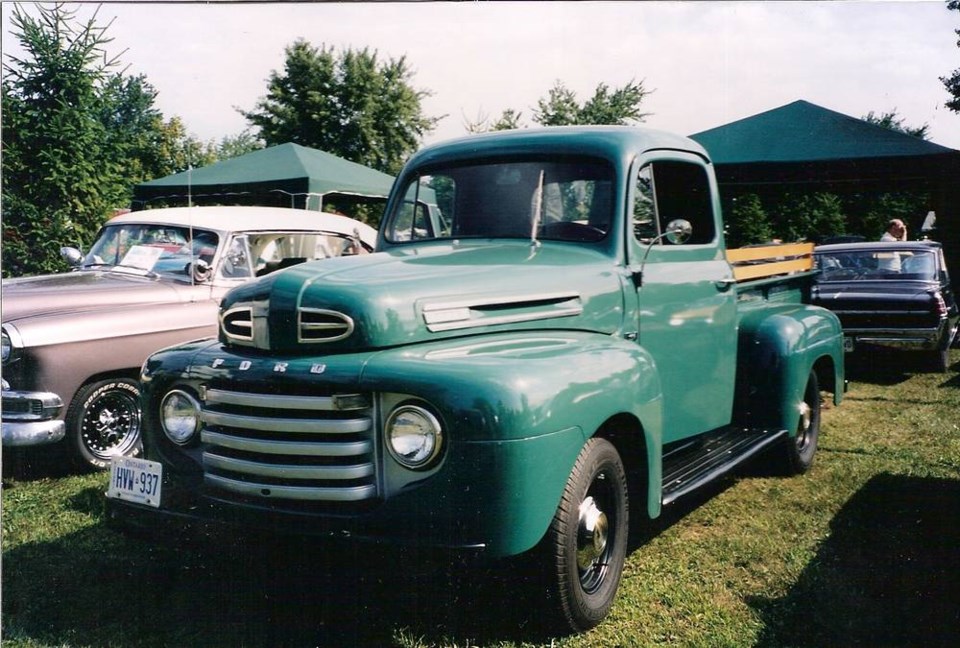Ford Motor Co. was formed in 1903 and produced its first commercial “delivery car” in 1905, a panel truck body on a Model C Ford car chassis. It was discontinued after only one year and production of just 10.
Ford’s concentration was on cars and those wanting a Ford truck bought a running chassis and made arrangements with a commercial body builder.
Ford’s return to trucks was Model T-based, usually panels, closed cab express types and depot hacks (station wagons). By 1917 the Model T Roadster Pickup had evolved into what we would recognize as a pickup truck.
Ford finally got serious about pickup trucks in 1925 with its first factory built model. It was still car-based, however, with a cargo box mounted behind a car cab.
Pickups evolved as a distinct model during the 1930s as they gradually moved away from being based on passenger cars and became more purposeful and utilitarian.
Ford’s new 1938 pickup looked functional and commercial compared with the Ford car. From then on, apart from the sedan-pickup Ranchero introduced in 1957, their cars and trucks travelled divergent paths.
The Second World War prevented updating Ford’s pickup until 1948 when it introduced our subject, the soon-to-be-famous Ford F-Series truck line.
The F-1’s payload was a half-ton, the F-2 three-quarter ton, on up to heavy duty F-7s and F-8s. The F-Series was Ford’s first new post-war model, beating the new 1949 Ford car to market.
To accommodate a different dealer structure Ford of Canada’s “badge engineered” Mercury version of the Ford pickup arrived in 1946. Virtually identical to Ford, it continued until 1968.
That new modern post-war 1948 Ford F-Series had a one-piece windshield, a horizontal bar grille and businesslike appearance. A 1951 restyling brought a wider a grille with integrated headlamps.
That evolved into the 1953 Golden Anniversary model to celebrate Ford’s 50th anniversary. The F-1 became the F-100 and featured a higher, roomier cab, curved windshield and 50 percent greater glass area. By this time the pickup trend was to car-like comfort and convenience options like automatic transmissions and power steering and brakes
The F-100 had no major changes for several years. The ‘55 received key starting and tubeless tires, and in 1956 a wraparound windshield and optional “panoramic” rear window.
The 1957 F-100 pickup was extensively redesigned and included a new model called the Styleside with a wider box and integrated front fenders and hood. The traditional fendered Flareside model continued.
The Styleside’s full-width cargo box was the shape of the pickup’s future. By eliminating rear fenders and running boards it offered the utility and style of the luxurious Chevrolet Cameo Carrier pickup at a much lower price.
Ford made a technical breakthrough in 1965 with its novel “Twin I-Beam” coil spring front suspension that mounted the wheels on long swing axles pivoting on anchors at opposite sides of the chassis. Axle location was maintained by radius rods.
Ford said Twin I-Beam combined the advantages of independent front suspension with the ruggedness of a beam axle, and promised such improvements as less tire wear and a better ride. It was superseded in 1980 by the similar Twin-Traction Beam, which was eventually replaced by traditional A-arms and coil springs that allowed lower engine placement.
Ford brought minor F-100 improvements for several years with facelifts for 1967 and 1974. Extended “Super Cab” cabs with passenger seats behind the regular seat became popular.
More aerodynamic styling was adopted for 1980, and in 1984 the F-100 nomenclature was replaced by the F-150 to reflect increased payload capacity.
Another more luxurious F-150 iteration came for 1997, reinforcing the market forces that had been influencing pickups since the 1950s when their use began extending beyond commercial purposes.
Adapting to a higher fuel economy future, Ford’s 2011 F-150 engine line included a high-tech 3.5 litre, twin turbo, direct injection “Ecoboost” V-6 developing V-8-like horsepower. A 2.7 V-6 Ecoboost would also come. They capped a line of Ford truck engine types that included the early side-valve four, the 1932 V-8 (first V-8 truck) and side valve and overhead valve sixes and V-8s.
Cabs got larger and more aerodynamic and extended-cab versions’ extra doors provided easy rear seat access. Virtually every safety, luxury and convenience feature was available, including a clever step-up to the box. Dual airbags and ABS brakes became standard.
In 2015 Ford took a bold step by making the F-150’s body out of military grade aluminum. Although expensive to develop, it saved weight and provided better rust protection.
Ford’s F-Series pickup truck has been the bestselling vehicle in North America for several decades. It has come a long way in its over 70 years, but still carries the spirit and DNA of that original, and now rather small looking, 1948 F-1.



